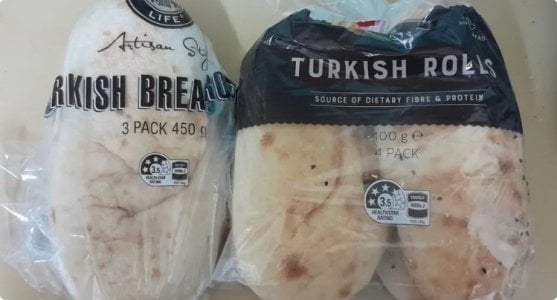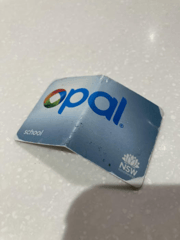Detail spotted in ALDI bread sparks debate
- Replies 28
As the cost of living continues to rise, Australians are becoming increasingly savvy about where their dollars are going, especially when it comes to grocery shopping.
ALDI, known for its competitive pricing, has recently come under scrutiny for a certain tactic.
This phenomenon has sparked a heated debate among consumers demanding transparency and value for money.
The term 'shrinkflation' is a tactic that involves subtly reducing product sizes while maintaining the same price point.
The latest instance involved ALDI's Baker's Life Turkish Bread Rolls, which have undergone a noticeable change.
The original 450g three-pack has been replaced by a 400g four-pack, now including nigella and sesame seeds, yet the price remains at $2.69.
This subtle downsizing did not go unnoticed, with one ALDI customer taking to social media to voice their concerns, stating, 'Shrinkflation in ALDI once again.’
They continued, ‘This post was more to spread awareness than complain, but I think a 50g drop in the product’s weight in one go is quite excessive, no matter how anyone justifies it!’
‘Say there’s 20 packs in a tray, for example, that’s 1kg less that they are selling for the same price as the week before. Gives you something to think about.’
Many expressed their frustration in the comments section of her post.
‘Massive difference! I wasn’t at all impressed when I [saw] these myself yesterday,’ one said.
‘Oh dear, we are doomed. Everything is shrinking. They think we are s*****. Everything [is] getting smaller and prices are up,’ another commented.
Retail expert Professor Gary Mortimer weighed in on the issue, explaining that shrinkflation is often necessary for supermarkets to absorb increasing manufacturing costs without passing on a price hike to consumers.
‘What we are finding is that supermarkets and manufacturers tend to look at ways they can reduce costs while keeping prices low, such as reducing content whilst maintaining the same cost and retail price. Most customers don't notice when you're dealing with 50g,’ he explained.
According to Professor Mortimer, adjustments need to be made with increased production costs, and reducing portion sizes while maintaining prices helps alleviate the impact on consumers at the checkout.
He also noted that customers generally prefer slightly smaller portions in a package rather than paying more for the product and mentioned that shrinkflation is not a recent phenomenon.
‘Manufacturers have engaged in content reduction strategies for many years,’ he said.
‘We could look at brands like Cadbury's which have been known to shrink the size of the chocolate.’
Finder Personal Finance Expert, Sarah Megginson, mentioned that economical customers were ‘catching on’ shrinkflation techniques, and frequently airing their discontent online.
‘There are ways to tackle shrinkflation, and make sure you’re getting the most value out of what you’re buying. However, it really puts the onus on you as a consumer to be on alert,’ she said.
She also advised shoppers to stay vigilant by reading product labels, trying alternative brands, and stocking up during sales to combat the effects of shrinkflation.
Meanwhile, Chris Ford from Compare the Market, pointed out that many consumers are unaware of the rising production costs, including transportation and supply chain issues, which ultimately affect prices at the checkout.
ALDI responded to the outcry by confirming a product configuration change from three to four rolls to meet consumer demand, alongside adding new ingredients, which resulted in a change in unit pricing.
The retailer emphasised that ALDI stores provide transparent unit pricing of cost per 100g on all shelf labels, allowing customers to make informed decisions.
Recently, another item—from Woolworths this time—became an example of shrinkflation, which was also not appreciated by its shoppers.
Meanwhile, another supermarket giant made a bold move to pressure manufacturers to take accountability for shrinkflation.

Have some of your favourite grocery items been hit with shrinkflation, too? How do you ensure you're getting the best deal? Share your stories and suggestions with us in the comments below.
ALDI, known for its competitive pricing, has recently come under scrutiny for a certain tactic.
This phenomenon has sparked a heated debate among consumers demanding transparency and value for money.
The term 'shrinkflation' is a tactic that involves subtly reducing product sizes while maintaining the same price point.
The latest instance involved ALDI's Baker's Life Turkish Bread Rolls, which have undergone a noticeable change.
The original 450g three-pack has been replaced by a 400g four-pack, now including nigella and sesame seeds, yet the price remains at $2.69.
This subtle downsizing did not go unnoticed, with one ALDI customer taking to social media to voice their concerns, stating, 'Shrinkflation in ALDI once again.’
They continued, ‘This post was more to spread awareness than complain, but I think a 50g drop in the product’s weight in one go is quite excessive, no matter how anyone justifies it!’
‘Say there’s 20 packs in a tray, for example, that’s 1kg less that they are selling for the same price as the week before. Gives you something to think about.’
Many expressed their frustration in the comments section of her post.
‘Massive difference! I wasn’t at all impressed when I [saw] these myself yesterday,’ one said.
‘Oh dear, we are doomed. Everything is shrinking. They think we are s*****. Everything [is] getting smaller and prices are up,’ another commented.
Retail expert Professor Gary Mortimer weighed in on the issue, explaining that shrinkflation is often necessary for supermarkets to absorb increasing manufacturing costs without passing on a price hike to consumers.
‘What we are finding is that supermarkets and manufacturers tend to look at ways they can reduce costs while keeping prices low, such as reducing content whilst maintaining the same cost and retail price. Most customers don't notice when you're dealing with 50g,’ he explained.
According to Professor Mortimer, adjustments need to be made with increased production costs, and reducing portion sizes while maintaining prices helps alleviate the impact on consumers at the checkout.
He also noted that customers generally prefer slightly smaller portions in a package rather than paying more for the product and mentioned that shrinkflation is not a recent phenomenon.
‘Manufacturers have engaged in content reduction strategies for many years,’ he said.
‘We could look at brands like Cadbury's which have been known to shrink the size of the chocolate.’
Finder Personal Finance Expert, Sarah Megginson, mentioned that economical customers were ‘catching on’ shrinkflation techniques, and frequently airing their discontent online.
‘There are ways to tackle shrinkflation, and make sure you’re getting the most value out of what you’re buying. However, it really puts the onus on you as a consumer to be on alert,’ she said.
She also advised shoppers to stay vigilant by reading product labels, trying alternative brands, and stocking up during sales to combat the effects of shrinkflation.
Meanwhile, Chris Ford from Compare the Market, pointed out that many consumers are unaware of the rising production costs, including transportation and supply chain issues, which ultimately affect prices at the checkout.
ALDI responded to the outcry by confirming a product configuration change from three to four rolls to meet consumer demand, alongside adding new ingredients, which resulted in a change in unit pricing.
The retailer emphasised that ALDI stores provide transparent unit pricing of cost per 100g on all shelf labels, allowing customers to make informed decisions.
Recently, another item—from Woolworths this time—became an example of shrinkflation, which was also not appreciated by its shoppers.
Meanwhile, another supermarket giant made a bold move to pressure manufacturers to take accountability for shrinkflation.
Key Takeaways
- ALDI shoppers discussed the supermarket's 'shrinkflation' after noticing a pack of Turkish bread had its contents reduced from three larger rolls to four smaller ones without a price change.
- Retail expert Professor Gary Mortimer explained that shrinking product sizes, while keeping prices the same, helps stores absorb increased production costs and avoid passing additional costs onto consumers.
- Consumers are becoming increasingly aware of 'shrinkflation' strategies and are encouraged to check product labels and consider alternatives to ensure value for money.
- ALDI confirmed a change in their Turkish bread product to meet consumer demand, which includes new ingredients and a different weight, while maintaining transparent unit pricing on shelf labels.
Last edited:








